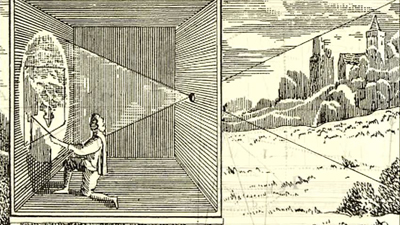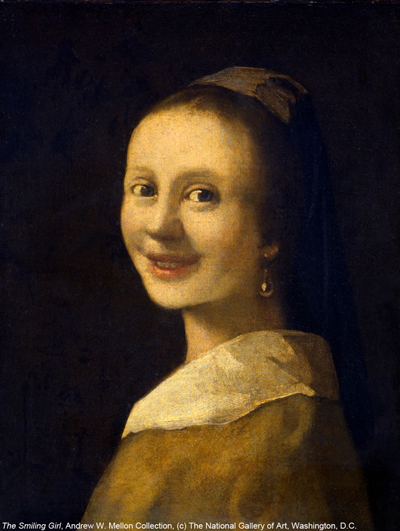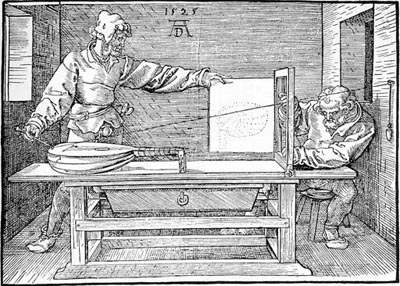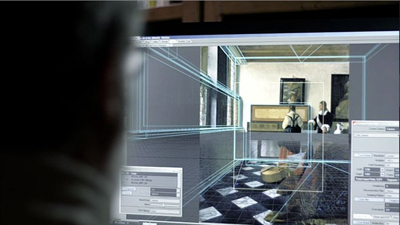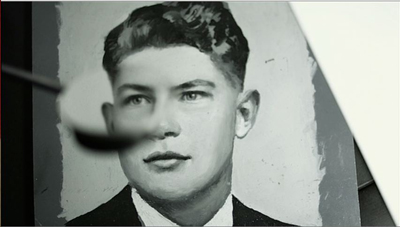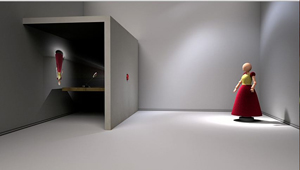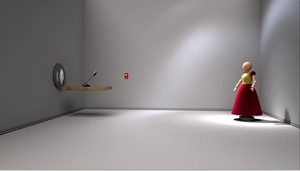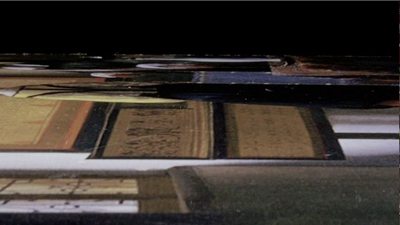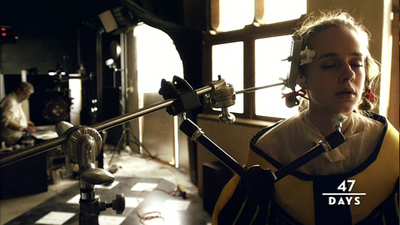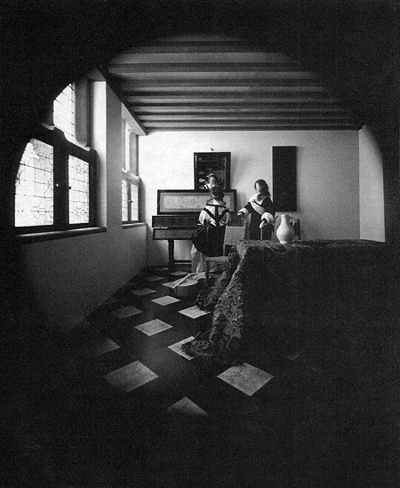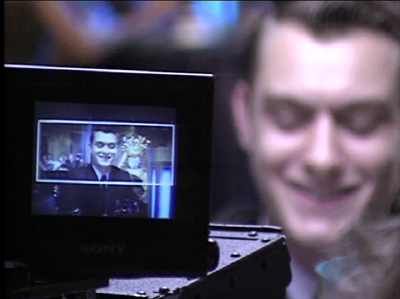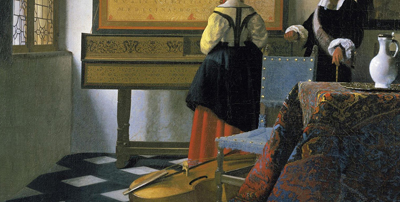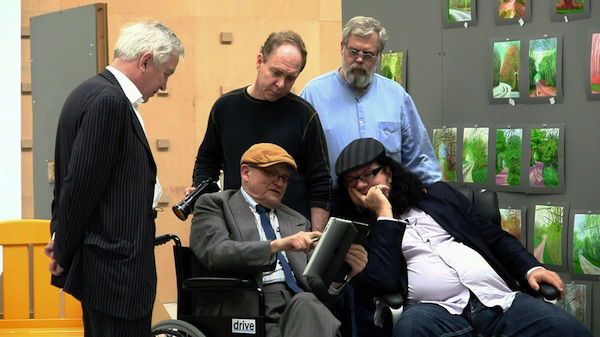I am a camera, sometimes: TIM’S VERMEER
Monday | February 3, 2014 open printable version
open printable version
DB here:
Sometimes you sense that a film is made especially for you, and you expect to enjoy and admire it well before you see it. This happened, I guess, with millions of people and films like Star Wars, Twilight, and The Hunger Games. I didn’t share those viewers’ hopes, but I knew from advance publicity that I would be keenly interested in the new documentary, Tim’s Vermeer.
Why? It involves Penn & Teller, two demigods of mine; it’s about art and technology; and it investigates the possibility that a painter used optical devices to create glowing, mysterious images. In the process, it reawakens the controversy around David Hockney’s thesis in Secret Knowledge that many old masters were employing lenses and mirrors to render nature with unprecedented richness.
I wasn’t disappointed. It was the most intellectual fun I’ve had at the movies in the last year.
It’s hard to explain technical stuff clearly, and even harder to dramatize it so that audiences are engaged. Tim’s Vermeer teaches you a lot about art, technology, and human will and skill. The personality of the central figure makes the tale engrossing and funny, often suspenseful, and at moments a little wistful. At the same time you get to study one of the greatest paintings in the western world in a thoroughly unpretentious way.
There, I’ve made my recommendation. Stop now if you want your experience completely unsullied. But you’ve perhaps read other reviews, and nearly everything I mention in what follows is mentioned in at least one of those. Sony Pictures Classics has kindly put the screenplay online, so there really are no secrets if you’re determined to know it all. I want merely to convey some of the excitement the film gave me. It explores a fascinating problem in art history through one man’s patience, ingenuity, and determination.
Tim Jenison, a wealthy software innovator, is a polymath—musician, tinkerer, and fan of art. He is not a painter, but he works with images constantly; part of his fortune derives from Video Toaster and other postproduction software. He comes across as articulate, avuncular, and gifted with a self-deprecating sense of humor.
In 2001 Tim learned of two recently published books, Hockney’s Secret Knowledge: Rediscovering the Lost Techniques of the Old Masters and Vermeer’s Camera, a more academic investigation by Philip Steadman. Steadman made a strong case for Vermeer’s use of a camera obscura in painting his pictures.
The camera obscura is a box that uses a small hole and lens to project an image of the scene outside the box. The image appears, inverted and flopped side to side, on the wall opposite the lens. Project the image onto a drawing surface, and you can trace it, although it’s difficult and requires a lot of practice.
The photographic camera is such a device, using film stock or a chip to fix the image. Amateurs used portable camera obscuras for some centuries before photography, and there’s evidence that Canaletto and other major artists employed them. A camera obscura (or “dark room”) can be any size, and it’s possible to set one up as a booth in a parlor. This is what Steadman suggested Vermeer did. Features of the paintings, such as perspective convergence and certain visual distortions, were characteristic of camera obscura images.
Hockney made bigger claims. He proposed that use of the camera obscura, along with convex mirrors and other optical gear, went far beyond Vermeer and a few other image makers. Caravaggio, for instance, seemed to him a master of staging tableaux vivants in his cellar and then copying what his array of gadgets yielded—in effect, creating a photographer’s studio.
Hockney’s proposals created a storm of controversy, with art historians, optical scientists, and cultural critics driven to fury. A common ad hominem complaint was that Hockney didn’t draw well himself and used photography to help him, so he would naturally denigrate a draftsman of genius. You can see some links to the debate in this entry’s codicil.
Steadman, a historian of architecture, used the perspective presented in the paintings to calculate the dimensions of the room and the placement of the camera obscura, and as a result he could measure the size of the projected images, which uncannily matched the size of the finished paintings. Tim took another direction.
By reflecting the camera obscura image into a hand mirror that he could position just above the picture in progress, Tim found that without training or talent he could copy a scene with astonishing accuracy. He started without a camera obscura, just using the hand mirror to paint an image from a photo of his father-in-law. The result encouraged him to go farther—much farther.
Tim’s Vermeer documents Tim’s painstaking process. He used 3D mapping to plot the space shown in The Music Lesson. He then built the room and furnished it with life-size replicas of the furniture and fittings. He ground authentic versions of the pigments and lenses used in Vermeer’s era. He even found models to stand, fixed in place by clamps, while he painted, with infinitesimal slowness, the image caught by his lens and hand mirror. By trial and error he found that adding another mirror helped even more. He was painting from a three-dimensional scene, as captured on a camera obscura.
The entire project consumed 1825 days. Documentaries always document more than they intend to, and part of the film’s attraction is its portrait of a man driven to the limit to test his hunches. His presence adds a human narrative to what could have been considered a dry academic debate. You have to wonder what Herzog would have made of this multimillionaire spending years trying to replicate a masterpiece.
Tim’s obsession yielded a remarkably exact version of the scene done entirely by hand, eye, and optical devices. The film shows Hockney and Steadman approving Tim’s picture as a valid “proof of concept,” as he calls it.
The film is carefully clear about what Tim’s demo didn’t prove. He hasn’t shown that Vermeer did it this way. We have in fact no written documents concerning how Vermeer produced his pictures, so our inferences are based wholly on the paintings and the historical circumstances. For example, Antony Van Leeuwenhoek, celebrated microscopist, lived in Delft at the same time and served as executor of Vermeer’s estate. But no documents indicate that they discussed lenses, or even knew one another.
Nor has Tim proved that he’s as good as Vermeer. Hockney insists that paintings are marks and “machines don’t make marks.” Vermeer’s touch may be inimitable and owe nothing to optics.
And Tim hasn’t supported Hockney’s suggestion that there’s no other way Vermeer could have gotten his distinctive look. Admittedly, thanks to perceptual psychologist Colin Blakemore, Tim found that Vermeer’s pictures include visual phenomena that aren’t available to our unaided eye, such as fine gradations of light on a pebbly surface. Still, perhaps Vermeer was familiar with optically generated images and imitated them, freehand, in his pictures. Perhaps he used a camera obscura simply as inspiration and a guide to visual discovery.
What Tim has shown is that a simple knowledge of how light behaves in mirrors and lenses–knowledge that was available in Vermeer’s milieu—could enable someone to produce images of extraordinary accuracy and detail, if he or she were willing to expend a hell of a lot of time and trouble.
Lawrence Gowing suggests that to Vermeer the drudgery that Tim underwent was exhilarating.
It was in the camera cabinet perhaps, behind the thick curtains, that he entered the world of ideal, undemanding relationships. There he could spend the hours watching the silent women move to and fro.
Maybe Vermeer was, as Tim suggests, an ancestor of today’s CGI geeks, toiling over his picture for days and weeks, though without the benefit of pizza and Mountain Dew. There are thousands of such people today. Were they around then too? Was Vermeer the first keyboard monkey?
The outsider’s risk
Here are some objections to the Hockney-Steadman-Jenison line of argument. I don’t think they’re insurmountable.
There are always crank theories around. But although the public discussions of Hockney’s thesis came close to calling him nuts, it’s worth listening to an artist’s conception of how another artist might work—especially when the skeptics aren’t practicing artists themselves. Hockney isn’t proposing the sort of numerological theories we get, say, in the film Room 237, or the “secret geometries” line of argument that maintains that every line and mass proves the artist was a Rosicrucian or a Freemason. Hockney’s theory may be wrong, but it’s not wacko.
Jenison is a naïve dabbler from outside the art world and lacks certified expertise. Again, it’s not a matter of who floats an idea but how valid the idea is. Why couldn’t a computer-graphics expert come up with enlightening ideas about pictures? Craftsmen in any domain often spot fine points that lay people can’t.
Besides, insiders can be mistaken. Forgers have long fooled connoisseurs. The Smiling Girl picture above was shown as a Vermeer at London’s Royal Academy in 1929, but now it’s regarded as a fake.
It’s too easy. If this were all there were to painting lifelike pictures, you might say, any kid could do it. Well, not many would have the patience. Tim spent 130 days painting the picture and he nearly gave up. It was stressful, hard on his back, and strewn with unexpected obstacles. He had to take frequent breaks. Freehand drawing is a lot easier, not to mention faster. Although Tim is no painter by training, he clearly has a careful eye and extreme fine motor control in his fingers. I, who can scarcely draw a straight line with a ruler, couldn’t do what he did.
It’s too hard. Tim’s painstaking dabbing is laborious, others might grant, but it’s donkey work. His conception of art is “difficulty of doing,” but there are lots of things that are hard to do, like building ships in a bottle, and they aren’t art. But all art requires discipline, and in those times experts labored for days over bits of the canvas that hardly anybody would notice. As a craft, painting is inherently hard, but we can scarcely imagine the amount of energy invested in the voluptuous images of Vermeer’s period. Damien Hirst can whip up high-priced paintings fast for today’s market, but conditions at that time would slow him down. He’d probably have to catch his own shark.
It’s too reliant on technology. But art has used mechanical devices for centuries. The best examples, very relevant to Vermeer, are all the drawing aids associated with perspective, including not just straightedges and protractors but complex gadgets like Durer’s famous converging-string setup that allowed him to draw curved volumes.
Such devices are shortcuts to deploying the geometry of the system. As Steadman says in the film, “Perspective is an algorithm.”
Later eras have given us much art dependent on technology, from tubes of oil paint to Hockney’s own Polaroid- and iPad-assisted imagery. And of course film and video art wouldn’t exist without machines. Hockney puts it well from the standpoint of the practicing painter:
[Raphael] would have wanted to make as vivid a portrait as he could. As a professional painter, he had a job to do and would have used all the tools at his disposal, including, if he thought they would help, lenses. He would not think, “I’m a great artist at the height of the Renaissance who should disdain such methods.”
Hockney and Steadman report that practicing artists they’ve encountered have been far less hostile to their ideas than art historians have been.
It insults greatness. I suppose this is what Susan Sontag meant by saying, “If David Hockney’s thesis is correct, it would be a bit like finding out that all the great lovers of history have been using Viagra.”
Actually, the copying of a camera obscura image isn’t as mechanical as one might think, but even if it were, would it be devastating? We allow photographers, with their mechanisms for intercepting light rays, the status of great artists.
The objection rests on a valid point. We do need to know something of how an artwork was made in order to understand and judge it. But in this case I don’t think that discovering that Vermeer used mechanical aids would minimize our appreciation of the pictures. It might, however, change our sense of how he relates to the traditions that followed. This change in our understanding is something Hockney and Jenison hope to bring about.
It dispells the mystery. This is the toughest argument to counter because it assumes that we want mystery in our art. It seems to me ultimately a religious way of thinking about art. I’m enough of a rationalist to hope that in any area, research can turn some mysteries into puzzles, then turn puzzles into problems, and maybe solve some of the problems.
There’ll always be a residue of questions we can’t answer. Given the feeble progress we’ve made in understanding art, no one should worry. We researchers nibble at the edges, and the Big Mysteries aren’t going away any time soon. In the meantime, we can ask whether Tim, along with Hockney, Steadman, and others, has answered some worthwhile questions about how Vermeer made his pictures.
My wish list
Here are some matters that a longer film would probably have been able to tackle. I’d love to see a version that did.
How does Vermeer fit into the broader history of art? The painting traditions in which Vermeer worked—genre scenes, portraiture, perspective–aren’t articulated in the film. In addition, the use of the camera obscura by other painters could be brought out. Perhaps the assumption is that Hockney covered that territory.
Still, to avoid certain accusations, it might have been better to grant that artists blend talent, training, and hard work with selective knowledge of what earlier artists have done, and what rivals are up to. E. H. Gombrich emphasizes the various factors involved: the tasks that artists undertake, their tools, their techniques (including inherited visual patterns, or schemas), the problems inherent in a project, and the artist’s circumstances, such as competition with other artists and the fluctuating tastes of their audience.
The exactitude of Vermeer’s interiors, for instance, is in tune with contemporary Dutch paintings of household routines (so-called genre painting) and of still-life paintings of foods glistening on a tabletop. There was a taste for meticulous presentation of everyday life at the time, and this probably impelled Vermeer toward his unique brand of realism. Was he trying to top his rivals? The film suggests that his delicacy and precision surpass what’s on display in contemporaries like Pieter de Hooch.
What counts as realism? Vermeer’s pictures look fantastically accurate, and have for some time. But he selects only certain dimensions of reality to capture. Other painters focus on movement, which is all but absent from Vermeer’s images. There’s a snapshot quality to Baroque representations of figures in action, which look scarily realistic. And many other painters render details that impress from a distance or even close up; Jan Van Eyck is probably the most famous.
What about the lenses and mirrors? Tim goes to great lengths to mimic the features of Vermeer’s room and to mix paints as he might have. The film is mostly silent, though, about his optical devices. What focal lengths were the lenses in camera obscuras? We know that different focal lengths render perspective in differing ways. Some of the distortions commentators have found in Vermeer’s picture seem to proceed from wide-angle coverage. Moreover, Tim’s hand mirror and convex mirror seem to be modern ones. Are these enough like what Vermeer would have had available?
Did Vermeer alter the perspective projection he obtained? Many painters who calculated perspective felt free to adjust it or confound it for the sake of expressive effect. Famous pictures are full of inconsistent vanishing points, often masked by figures or items of setting. Tim’s painting obeyed what his camera gave him, but perhaps Vermeer adjusted his image. Consider, below, some details from Vermeer’s picture (left) with Tim’s (right). (Ignore color differentials, since the reproductions of the original vary so much.)
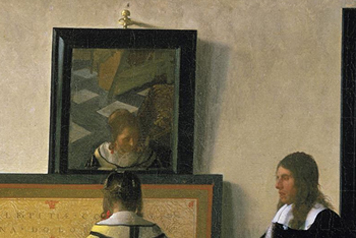
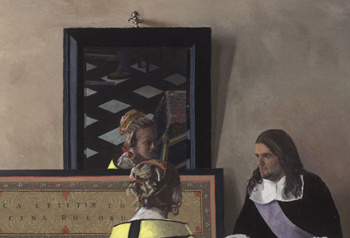
Did Vermeer fiddle with what the camera showed? I’m not thinking so much of the disparities in the placement of the figures above, which are probably to be expected; we’d be shocked if Tim’s setup worked exactly the same as Vermeer’s. I’m more concerned with the way in which Vermeer seems to have cheated perspective with respect to the reflection.
It looks as if Tim tried to match the reflection, but to do that he had to have his daughter turn slightly to the right. Yet Vermeer’s young woman faces the mirror head-on, while the reflection shows her in high-angle three-quarter view. Was the mirror slightly tipped on the left edge? And did it hang out from the wall slightly more than in Tim’s chamber? I wonder if Vermeer simply wanted to have it both ways–a head turned squarely away from us, a reflected face that wouldn’t be gazing straight out but rather pensively downward. Classic pictures often contain such expressive compromises with geometrical exactness.
Do we overrate the clean image? Tim, coming from the computer-graphics world, seems to have accepted the current assumption that the most faithful and attractive image is razor-sharp. He’s fascinated by the undeniably exact textures on the fabric and the wood and plaster surfaces. He thinks that Vermeer ‘s images resemble “a video signal” and that they glow like the images on a movie screen (that is, nowadays, a digital image).
But Tim’s High-Def aesthetic plays down some of painting’s traditional resources, notably sfumato. And art historian E. H. Gombrich notes that Vermeer’s precision retains “mellowed outlines” and doesn’t seem harshly photographic. Going back to the details above, to my eye, Vermeer’s image isn’t as sharp as Tim’s. The faces are sketchier, and the shadows have softer contours.
Gombrich and others have made much of the crucial role of suggestion and incompleteness in painting, especially paintings that are seen at a distance. Our perceptual systems fill in dashes and blobs with specific features, but Tim’s algorithm may chop too fine. The difference should give comfort to the people who emphasize Vermeer’s idiosyncratic paint handling. It would be worth seeing if Tim thinks he could recalibrate his pictorial mesh to soften the image somewhat.
Problems and solutions
Tim’s Vermeer is an entertaining lesson in how rational inquiry into the arts proceeds—posing a problem and then using inference and evidence to frame possible solutions. The film also shows how a problem usually has many facets, which sometimes have to be dealt with piecemeal.
A piecemeal approach is particularly pertinent to reconstructing Vermeer’s methods. Many art historians would grant that he, like others, might have used a camera obscura to imagine or sketch out the basic composition of the piece. But the crucial later phases of painting would have been carried out by eye and hand unaided. What is characteristic of the Hockney—Steadman—Jenison line is they try to indicate how much of Vermeer’s practice can be accounted for by optical aids.
Assume that Vermeer used a booth-type camera obscura. That device could yield general contours. Steadman charted other features of the camera obscura that show up in the master’s paintings, such as variable focus, light scattering, and perspectival distortion characteristic of lenses. He went on to build a scale model of the room depicted in The Music Lesson and other pictures, and showed that Vermeer might have used a booth-type camera obscura. With the cooperation of the BBC, Steadman built a life-size model of the system he discovered.
Reading Steadman’s brilliant book when it appeared, and then visiting his website where things are spelled out a little more, pretty much convinced me of his argument. But I didn’t think much about lighting or color.
Vermeer’s “mellowed outlines” are often given by minute shadings of tonality rather than firm outlines. Yet when you’re in the booth, it’s so dark that you can’t determine color accurately. This is where Tim Jenison comes in. What sort of optical device could yield such gradations of color?
Tim discovered that a small mirror mounted on a rod over the drawing surface would allow an artist to build color patches, as well as masses and contours, by slightly shifting her gaze from the mirror’s reflection of the camera’s image to the picture being made. You’ve achieved the right tonality, Tim points out, when the edge of the mirror seems to disappear. In this image, the disc you see isn’t clear glass but rather a mirror reflecting the camera obscura’s image, which is outside the frame.
Dim light in the booth doesn’t matter because both the image and the color you match are illuminated uniformly. The result, in the film, shows a remarkable degree of similarity.
But the optical projection remains a bit pale and lacking in detail; more concentrated and focused light is needed. Teller’s film shows how Tim hit upon the idea of focusing and brightening the camera image by projecting it onto a concave mirror rather than a flat plane. A mirror is also a projecting surface, and its reflection can amplify the camera lens’s image. With this array of lenses and mirrors, you don’t need to work in darkness and you don’t need a barrier between you and the scene.
At this point, Tim’s demo has demolished the darkened chamber itself. Maybe this is what Vermeer actually used, although if he wanted to hide his methods, the booth with its wall or curtain would have been preferable.
Another lesson in rational inquiry: Controlling for variables can encourage anomalies to pop out. In drawing the harpsichord in the picture, Tim had assumed straight edges, which he outlines with a ruler. But in painting the undulating seahorse motif on the surface, he discovered that his lens rendered the motif as very slightly curved. When you check the painting, you find that Vermeer’s motif does the same thing.
The curve, which Tim dubbed “The Vermeer Smile,” is characteristic of the distortion yielded by a lens. Your eye and brain don’t see it that way, however, and painters working freehand would automatically make the seahorses prance in a straight line.
In short, just as Vermeer’s lens may have allowed him to make discoveries about the behavior of light, Tim’s lens gave him a new insight into Vermeer’s art.
Photography without film
Suppose we buy the whole package. Assume that Vermeer used Tim Jenison’s hardware. What then does his art consist of?
In Film Art: An Introduction we distinguish four areas of cinema technique: mise-en-scene, cinematography, editing, and sound. Editing and sound aren’t relevant to Vermeer (though Eisenstein might make an argument for “montage” operating within the master’s “shots”). But the other techniques are, if we imagine him making unmoving movies—that is, photographs.
Mise-en-scene involves what is photographed. Vermeer controls the setting, picks the props, and costumes, and arranges the lighting. He determines the color within the scene. He also stages the action, although there isn’t much movement. Gombrich calls his paintings “still lifes with human beings.”
Cinematography has an equivalent in Vermeer’s art too. He must select a lens for the camera obscura, and he has to focus it. Most commentators agree that painters who used the device focused on different areas of the scene as they needed to paint them. Vermeer doesn’t use film, of course, but he does have paint, and the properties of that medium have to be taken into account. In Tim’s words, as he sits brushing in tiny strokes, “I’m a piece of human photographic film.”
Vermeer also has to frame the scene, which is a bit tricky because the camera obscura doesn’t yield a rectangular image but rather a circular one. Here is Steadman’s reconstruction of the camera’s visual output, flipped to match the painting and reproduced in black and white.
Vermeer has to crop the projected image in advance, much as a cinematographer today has to visualize the image’s final shape as seen on the viewfinder or monitor.
Staging and framing in The Music Lesson yield an unusual composition. What’s the subject of the painting? The woman playing? She’s turned from us, seen from afar, and quite decentered. True, she’s reflected in the mirror. But Steadman shows that this mirror is ambiguously drawn. It also seems to be angled so as to conceal the opposite end of the room—a ploy familiar to scholars of early cinema, when such tipped mirrors hide the movie camera.
Thanks to the oddly empty space in the left half of the picture, our attention drifts often to the empty space separating window, furniture, and people. Vermeer is in effect painting the journey of light hitting various surfaces. The streaming sunlight endows a patch of the rug, the bottom of the viola, and the upholstery tacks with a glow and brightens the woman’s sleeve. Then it thins into a more diffuse illumination before hitting the jug as a brilliant pictorial climax.
Perhaps he’s painting how air looks.
Vermeer’s zones of choice and control overlap with those of a photographer or a filmmaker. Or those of an illusionist. As stage magicians, Penn and Teller know the classic putdown: “Aw, they do it with mirrors.” The film might be their answer: “Yeah, and it works.” They and Tim Jenison have created a landmark film that ponders the interplay of science, tools, and artistic creativity.
Special thanks to Michael Barker of Sony Pictures Classics and Merijoy Endrizzi-Ray of Sundance Madison. Thanks as well to Kristin Thompson, Diane Verma, and Darlene Bordwell for conversations about the film.
The controversy over Hockney’s theses can be traced in the Wikipedia entry The Hockney-Falco Thesis. My quotation from Susan Sontag comes from Wyatt Mason on ArtKrush. The camera obscura image of The Music Lesson comes from Philip Steadman, Vermeer’s Camera, p. 123, as does my Lawrence Gowing quotation (p. 165). I’m grateful to Steadman on many levels, not least because his website encouraged me, in 2002, to set up the one you’re visiting now.
For further information on the general research area, see Martin Kemp, The Science of Art: Optical Themes in Western Art from Brunelleschi to Seurat. Kemp corresponded at length with Hockney, and portions of their exchanges are included in Secret Knowledge.
Gombrich’s comments on Vermeer come from Chapter 20 of The Story of Art. His classic Art and Illusion elaborates his account of inherited pictorial schemas and their revision across history.
Hockney has defended the film and explained further. Kurt Anderson has offered a valuable overview of the making of Tim’s Vermeer in Vanity Fair. Several video interviews cast light on the process as well. Here Teller, Penn, and Jenison discuss the film with Kent Jones at Lincoln Center. David Poland sits down for a 30-minute interview with Penn and Jenison. Philip Steadman discusses how Tim’s ideas build on his book in this University College London video.
Jonathan Janson’s site offers good coverage of the film’s reception, here and here.
One reviewer considers Tim’s theory “wackadoodle” but misunderstands it, saying that “Vermeer might have created his masterpieces by putting his models in a camera obscura.” Then he told them scary stories in the dark, I guess. More attentive reviews of the movie include one by Peter DeBruge in Variety and another by Todd McCarthy in The Hollywood Reporter.
You know Penn and Teller as conjurors and hosts of the show Bullshit! (My favorite episode: the animal mind-reader.) Be sure to read their books too.
Team Vermeer: Standing: Philip Steadman, Teller, Tim Jenison. Seated: David Hockney, Penn Gillette.
PS 12 March 2014: Painter Jane Jelley has proposed a way that Vermeer could have made his pictures using a camera obscura but without mirrors. She reports success replicating that method herself. Her article and some background to her experiment are available here. I thank Ms. Jelley for writing me with this information. The controversy continues, which makes me happy.













